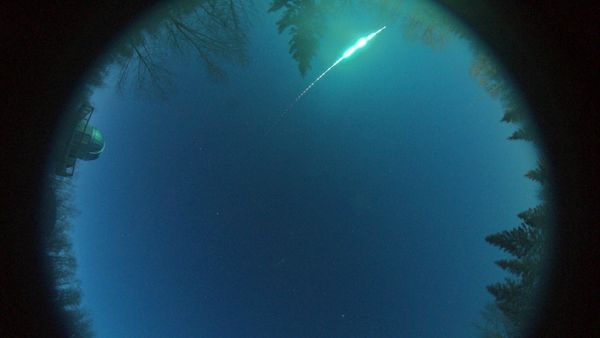Enormous fireball meteor turns the sky over Turkey green in eerie viral video
A stunning bright-green fireball was captured by a phone camera in a playground in Turkey.

A stunning video captured the moment a vibrant green fireball streaked across the skies above Turkey.
Taken by Onur Kaçmaz in a playground in the Turkish city of Erzurum on Saturday (Sept. 2), the now-viral video shows the sky and surrounding clouds bathed in a deep-sea snot green as the brilliant object hits the upper atmosphere.
A large green meteor was spotted blazing through the sky in Turkey moments ago.Wow. pic.twitter.com/eQEYLG2ihBSeptember 2, 2023
Fireballs are meteors that appear brighter than Venus, according to the American Meteor Society (AMS), meaning they are, in theory, visible in daylight. The blazing space rocks owe their startling brilliance to their large sizes and blistering speeds, which create a significant amount of friction when the rocks hit Earth's atmosphere. As the fireballs enter the atmosphere at speeds far exceeding the sound barrier — between 25,000 and 160,000 mph (about 40,000 to 257,000 km/h) — they can also be accompanied by a tremendous sonic boom.
Related: What are the largest impact craters on Earth?
Meteors begin to glow as their outer layers are stripped back by contact with Earth's atmosphere, leaving their metallic cores to burn from superheating. The bright-green coloring comes from nickel, which, along with iron, forms the most common component of a meteor’s core.
If a fireball explodes overhead, it can cause serious damage. The most explosive meteor event in recent history — which occurred over the city of Chelyabinsk, Russia, in 2013 — created a blast roughly equivalent to 400 to 500 kilotons of TNT, or 26 to 33 times the energy released by the Hiroshima bomb. Fireballs rained down over Chelyabinsk and its surroundings, damaging buildings, smashing windows and injuring approximately 1,200 people.
The Chelyabinsk explosion is far from the most apocalyptic event caused by a fireball. Recent archaeological evidence points to a fireball detonating over the ancient Middle Eastern city of Tall el-Hamman around 3,600 years ago. The explosion, which was roughly 1,000 times more powerful than the Hiroshima bomb, set the city instantly ablaze before leveling it with a powerful shock wave, killing all of its inhabitants.
Breaking space news, the latest updates on rocket launches, skywatching events and more!

Ben Turner is a U.K. based staff writer at Live Science. He covers physics and astronomy, among other topics like weird animals and climate change. He graduated from University College London with a degree in particle physics before training as a journalist. When he's not writing, Ben enjoys reading literature, playing the guitar and embarrassing himself with chess.

